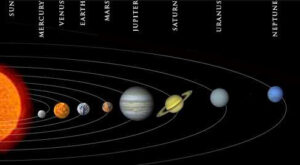There’s a Lot of Space in Space

Author(s): Dennis Eaton
Subject: Earth Science
Grade Level(s): Grade 3
Big Idea(s): The distances in space are so great that it’s difficult for anyone, let alone children, to comprehend how far it is between our planets. The charts that we see of our Solar System invariably, out of necessity, place the planets next to each other, further compounding the difficulty of understanding the sheer scale of our space “neighborhood”. This activity gives students some perspective with a “true to scale” model of our Solar System.
What you need: 100 foot or longer tape measure or measuring wheel
irrigation flags, preferably in as many different colors as possible
signs naming the planets that students can carry or wear
Solar System Scale sheet (attached)
bullhorn (optional, but definitely helpful once students are spread out)
“Bill Nye – Planets” video (available on ETC Portal, California Streaming/Video)
Setting: This lesson needs to be done on a grassy area on the playground.
Time Needed: 30-45 minutes, not counting setup and classroom followup.
Summary:
With the exception of the Sun and possibly Pluto, which is optional, several students will represent each planet in the Solar System, as well as the asteroid belt. Starting at the Sun, students will be sent to irrigation flags in the grass representing the scaled distance of each planet from the Sun. This scale model of the Solar System will give students a concrete idea of the relative distances of the planets from the Sun and each other.
Learning Goals / Objectives:
Students learn that there is a great deal of space between the planets, especially as you get past the terrestrial planets to the gas giants.
Standards:
3 ES 4.d. Students know that Earth is one of several planets that orbit the Sun and that the Moon orbits Earth.
3IE 5.e. Collect data in an investigation and analyze those data to develop a logical conclusion.
Background
One way of measuring the distances in our Solar System is to use the “astronomical unit” (AU), about 93 million miles, the distance between the Earth and the Sun. Using this unit of measure makes it easy to construct a reasonably accurate scale model of our planetary system, which is the basis of this lesson.
Setup:
Before the lesson, possibly at recess before the activity, stake out the irrigation flags in their proper places, using the measuring tape and the Solar System Scale sheet (attached).
Assign students to a particular planet before leaving the classroom. One student in each group should be in charge of the planet sign. Be sure to take a clipboard with you that has the planet assignments, as some students will forget their assignments between the classroom and the playground.
Anticipatory Set:
Ask students to name places on Earth that are far away… even places they have been. Ask them how long they think it would take to get there, by car, plane or other mode of transportation. Help them to come up with an accurate estimate, if necessary, keeping in mind that you can get pretty much anywhere on Earth by jet in less than a day. Explain that they are going to learn how far away the most distant objects in are Solar System are located.
Instructions / Activities:
1. Make sure students have been assigned a planet that they will represent.
2. The class gathers at the end of the playground that has the Sun irrigation flag.
3. Send the Sun students to the Sun flag, then the Mercury students to the flag representing Mercury, and so on through all of the planets.
4. Once everyone is in place, take turns by planet, allowing everyone (except for the sign holder) to stand off to the side to see how spread out the planets are in this scale model. This helps students see how vast the Solar System is.
5. Once students have had an opportunity to view the scale model from the side, have them pick up the irrigation flags and line up to return to class.
Assessment:
Formative assessments:
Upon returning to the classroom, have students discuss at their table groups what they observed/learned during the activity about the distances between the planets.
With their think/pair/share partner, give them a few minutes to discuss why they think the measurement called the Astronomical Unit was developed. Remind them that one AU is the distance between the Sun and the Earth. Call on volunteers to share with the class.
Ask a few true/false and yes/no questions about the activity and have students use the thumbs up/thumbs down signal.
Summative assessments:
In their Science Journals, have students “show me, don’t tell me” the meanings of “scale” and “astronomical unit”. They can draw pictures and/or diagrams with labels, but they cannot write a narrative to define the words.
End of unit test on the Solar System.
Wrap-up / Closure:
View the “Bill Nye – Planets” video, available on the ETC Portal under California Streaming/Video. It’s just over 23 minutes long. As always, Bill is fascinating to watch, but one part of this video is directly relatable to the activity in this lesson. He shows a different scale model (larger) of the Solar System, which is an excellent discussion starter after viewing the video. How does Bill’s model differ from the one we did on the playground? Why didn’t we use the same model Bill did?
Tags: Grade 3
Categories: Earth Science

